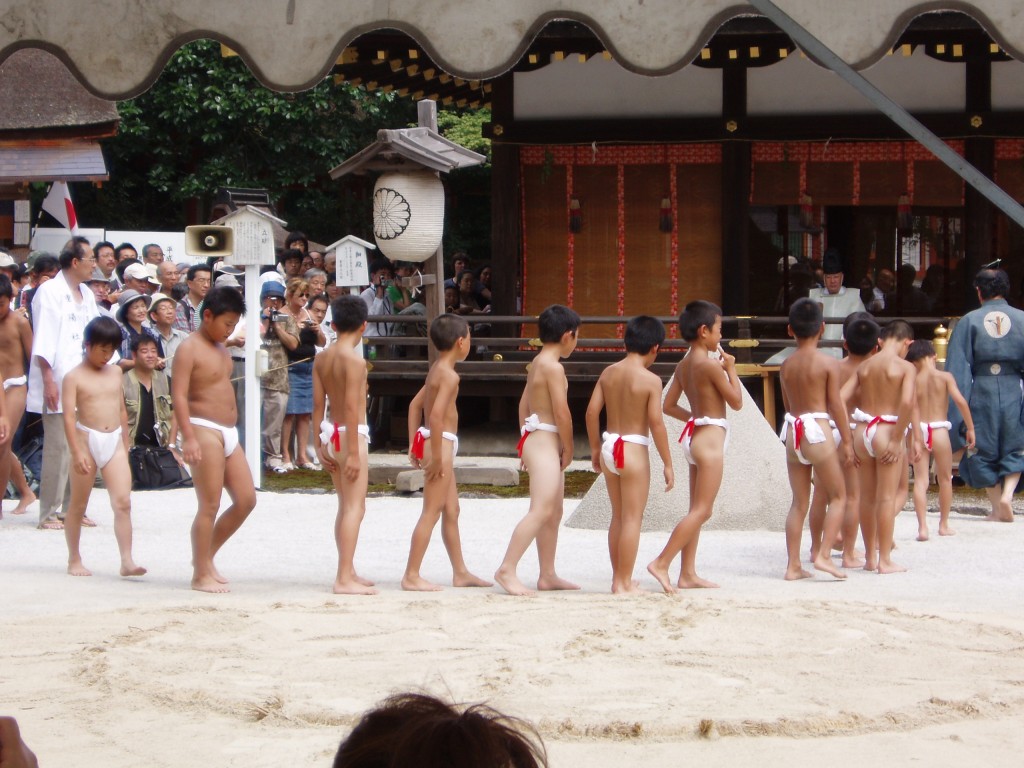
Sake and symbolic foodstuffs are lowered into a hole in the middle of the “dohyo” (ring) on Saturday, ahead of the New Year sumo tournament starting in Tokyo on Sunday. PHOTO BY MARK BUCKTON
*****************************************************
Extract from the Kokugakuin Encyclopedia of Shinto, written by Takayama Shigeru…
In China, there existed from before the Former Han dynasty (202 B.C.E.–8 C.E.) a kind of wrestling resembling sumō that belonged to the miscellaneous arts of sangaku. Some of these arts entered Japan… That competitions were decided through sumō wrestling in ancient Japan can be inferred from the existence of Kofun-period haniwa clay figures representing wrestlers, as well as from myths and legends, such as that of the test of strength between the kami Takemikazuchi and Takeminakata, recorded in the Kojiki (712).

Children's Sumo event is held every September at Kamigamo Shrine in Kyoto
Sumō wrestling bouts were also held as divination rites at New Year’s to predict the outcome of the coming agricultural season. Vestiges of sumō bouts held as a ritual shrine offering survive in various parts of Japan.
The Nihon shoki (720) records that in the seventh month of 642, “strongman wrestling” was held in the presence of Prince Gyōki of the Korean kingdom of Paekche — who was in Japan at the time — on the occasion of a visit to Japan by an envoy from the kingdom. This is the first piece of historical evidence available for sumō.
During the Nara period (710-784), sumō established itself as a court event. According to the Shoku Nihongi, a court position was created to oversee sumō wrestling in 719, and on the seventh day of the seventh month in 734 ceremonial sumō was held for the emperor. In the Heian period (794-1192) the sumō banquet became a customary court event. Messengers for the officials in charge of sumō were dispatched by the the imperial guard throughout the provinces to recruit sumō wrestlers.

One-man sumo performed at Oyamatsu Shrine in Shikoku (courtesy Japan Festival Guide)
Sumo bouts, called meshiawase, were held on the day of the banquet in the presence of the emperor. The wrestlers were divided into two sides (left and right) and paired off to produce as many as 20 bouts.
Accompanied by bugaku music, the banquet was a large-scale, spectacular event, but it also functioned as a prayer for bountiful harvests meant to divine agricultural production in the provinces. Though the banquet enjoyed great popularity from the early Heian period on, it was ultimately discontinued toward the end of the period in 1174.
During the Kamakura period (1193-1336), sumō seems to have been held only as a form of training for the samurai. In the Muromachi period, however, as the cities and towns stabilized their economic bases and became prosperous, sumō became popular among the common people and professional sumō appeared. Fund-raising sumō began at this time and flourished throughout the Edo period in both the Kamigata (Kyoto and Osaka) and Edo (modern Tokyo) regions.
Sumō reached its prime during this era, a time that saw such events as the awarding for the first time of the newly created top rank of yokozuna to wrestlers Tanikaze and Onogawa in 1789. The direct historical basis for today’s sumō lies in these fund-raising events.
As for shrine ritual sumō, one of the most well-known examples is the one-man sumō presented at the rice-planting festival of Ōyamazumi Shine, Ōmishima, Ehime Prefecture. Following the shrine ceremony, three bouts of sumō are held between a wrestler and the rice spirit, with the human contestant losing the first and third matches. These bouts function as a prayer for a rich harvest.
**************************************************************************************************************************************************
For a youtube video of the one-man sumo, click here (1 min video of a bout. The contest is the best of 3.)
For a youtube video of the New Year ritual performed at Meiji Jingu by this year’s two grand champions, click here (I min 30 secs long),

Former champion, the Mongolian Asashoryu, shows off the Shinto trappings of sumo (photo courtesy REUTERS/TORU HANAI)

Leave a Reply